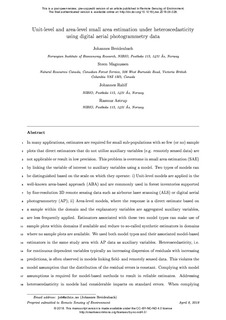| dc.contributor.author | Breidenbach, Johannes | |
| dc.contributor.author | Magnussen, Steen | |
| dc.contributor.author | Rahlf, Johannes | |
| dc.contributor.author | Astrup, Rasmus Andreas | |
| dc.date.accessioned | 2018-06-26T16:04:12Z | |
| dc.date.available | 2018-06-26T16:04:12Z | |
| dc.date.created | 2018-06-04T16:37:15Z | |
| dc.date.issued | 2018 | |
| dc.identifier.citation | Breidenbach, J., Magnussen, S., Rahlf, J., & Astrup, R. (2018). Unit-level and area-level small area estimation under heteroscedasticity using digital aerial photogrammetry data. Remote Sensing of Environment, 212, 199-211. | nb_NO |
| dc.identifier.issn | 0034-4257 | |
| dc.identifier.uri | http://hdl.handle.net/11250/2503076 | |
| dc.description.abstract | In many applications, estimates are required for small sub-populations with so few (or no) sample plots that direct estimators that do not utilize auxiliary variables (e.g. remotely sensed data) are not applicable or result in low precision. This problem is overcome in small area estimation (SAE) by linking the variable of interest to auxiliary variables using a model. Two types of models can be distinguished based on the scale on which they operate: i) Unit-level models are applied in the well-known area-based approach (ABA) and are commonly used in forest inventories supported by fine-resolution 3D remote sensing data such as airborne laser scanning (ALS) or digital aerial photogrammetry (AP); ii) Area-level models, where the response is a direct estimate based on a sample within the domain and the explanatory variables are aggregated auxiliary variables, are less frequently applied. Estimators associated with these two model types can make use of sample plots within domains if available and reduce to so-called synthetic estimators in domains where no sample plots are available. We used both model types and their associated model-based estimators in the same study area with AP data as auxiliary variables. Heteroscedasticity, i.e. for continuous dependent variables typically an increasing dispersion of re- siduals with increasing predictions, is often observed in models linking field- and remotely sensed data. This violates the model assumption that the distribution of the residual errors is constant. Complying with model assumptions is required for model-based methods to result in reliable estimates. Addressing heteroscedasticity in models had considerable impacts on standard errors. When complying with model assumptions, the precision of estimates based on unit-level models was, on average, considerably greater (29%–31% smaller standard errors) than those based on area-level models. Area-level models may nonetheless be attractive because they allow the use of sampling designs that do not easily link to remotely sensed data, such as variable radius plots. | nb_NO |
| dc.language.iso | eng | nb_NO |
| dc.rights | Attribution-NonCommercial-NoDerivatives 4.0 Internasjonal | * |
| dc.rights.uri | http://creativecommons.org/licenses/by-nc-nd/4.0/deed.no | * |
| dc.title | Unit-level and area-level small area estimation under heteroscedasticity using digital aerial photogrammetry data | nb_NO |
| dc.type | Journal article | nb_NO |
| dc.type | Peer reviewed | nb_NO |
| dc.description.version | acceptedVersion | nb_NO |
| dc.rights.holder | © 2018 Elsevier Inc. All rights reserved. | nb_NO |
| dc.source.pagenumber | 199-211 | nb_NO |
| dc.source.volume | 212 | nb_NO |
| dc.source.journal | Remote Sensing of Environment | nb_NO |
| dc.identifier.doi | 10.1016/j.rse.2018.04.028 | |
| dc.identifier.cristin | 1588889 | |
| cristin.ispublished | true | |
| cristin.fulltext | postprint | |
| cristin.qualitycode | 2 | |

